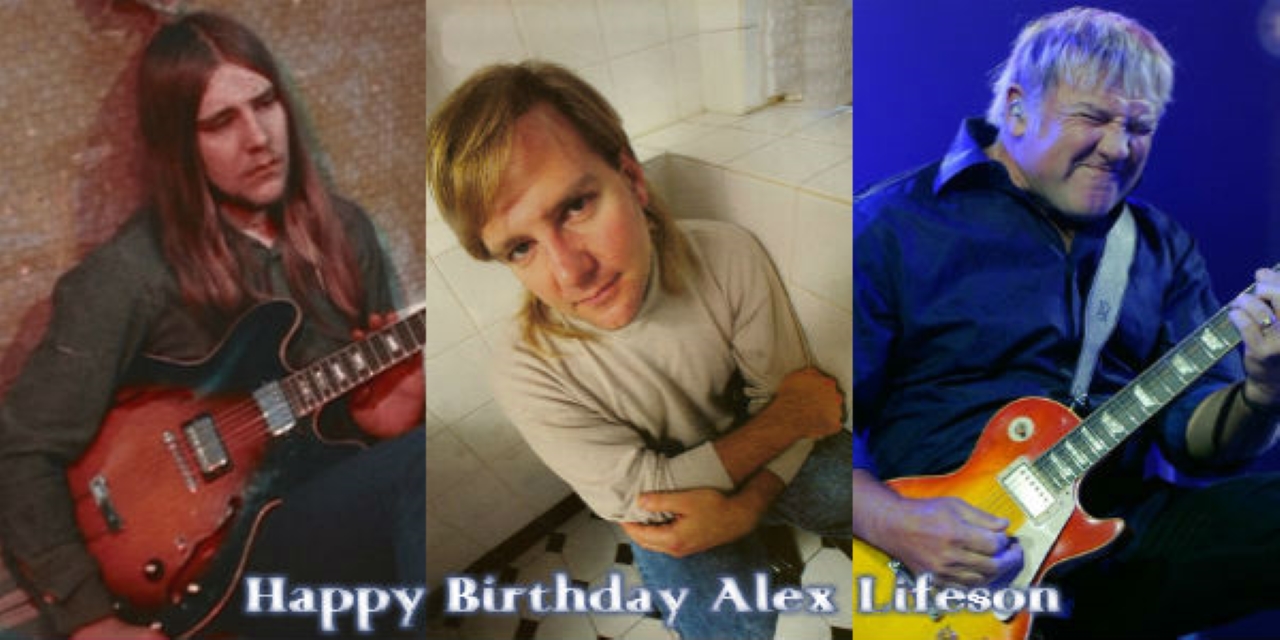🌟 The Quiet Genius in a Loud Band
When people speak of Rush, most will immediately think of Geddy Lee’s soaring vocals and thunderous bass, or Neil Peart’s intricate drumming and deeply poetic lyrics. Yet, standing slightly off to the side, with a wry smile and a guitar slung low, was Alex Lifeson — the sonic architect who gave Rush its emotional backbone. Born on August 27, 1949, in Fernie, British Columbia, Lifeson didn’t just play guitar. He painted vast landscapes of sound, creating textures and moods that made Rush far more than just another rock band.
Unlike the typical “guitar hero” of the 1970s and 80s, Lifeson never needed to drown the stage with flamboyant solos or ego. His genius was subtle but undeniable. Every chord, every riff, every improvisation was meticulously crafted, balancing technical wizardry with raw emotion. He could be angular and fierce in one song, then delicate and melancholic in the next.

🌀 From Suburbs to Stadiums
Rush began as three Canadian kids trying to make noise in the Toronto suburbs. By the mid-70s, they had already carved out a reputation for pushing rock into new territories. Lifeson was the cornerstone of this journey. His riffs in “Working Man” and “2112” announced that Rush was no ordinary band.
By the time albums like A Farewell to Kings and Hemispheres arrived, Lifeson had fully embraced the world of progressive rock. His guitar work fused classical inspiration, jazz experimentation, and the power of hard rock. The result was something entirely new — a sound that challenged listeners and musicians alike.
It wasn’t just about shredding. Lifeson’s use of open chords, delay effects, and unconventional time signatures made him one of the most innovative guitarists of his generation. When paired with Neil Peart’s complex rhythms and Geddy Lee’s melodic bass lines, the trio achieved a synergy rarely seen in rock history.
🎶 “La Villa Strangiato” – A Guitarist’s Playground
If one song defines Alex Lifeson’s legacy, it might be “La Villa Strangiato” from Rush’s 1978 album Hemispheres. Entirely instrumental, the nine-minute track is subtitled “An Exercise in Self-Indulgence” — yet it became a masterclass in progressive rock composition.
The song is essentially a dream sequence, split into twelve distinct sections. Lifeson’s guitar guides the listener through whimsical melodies, fiery solos, and sudden time signature shifts. From the haunting introduction to the playful jazz-inspired interludes, Lifeson proves that the guitar can tell stories without a single lyric.
Decades later, fans and musicians still point to “La Villa Strangiato” as one of the greatest instrumental rock compositions ever recorded. It captures Lifeson’s ability to merge technical brilliance with creativity, making it an essential listen for anyone who wants to understand what made Rush unique.
🌍 The Reluctant Guitar Hero
While his peers like Eddie Van Halen and Jimmy Page often embraced the spotlight, Lifeson seemed almost allergic to it. He was the everyman in a band of virtuosos, grounding Rush with humor and humility. Onstage, he often cracked jokes between songs, balancing the intensity of the music with his playful personality.
This humility didn’t diminish his influence. Guitar magazines consistently listed him among the greatest guitarists of all time. Musicians from Metallica’s Kirk Hammett to Dream Theater’s John Petrucci have cited him as a major influence. His ability to weave complex harmonies into rock music paved the way for countless progressive and metal bands.
💔 The Emotional Core of Rush
What set Lifeson apart wasn’t just technique — it was his ability to make the guitar feel human. Songs like “Closer to the Heart”, “The Spirit of Radio”, and “Limelight” carried a warmth and sincerity thanks to his playing. While Neil Peart’s lyrics explored philosophy and existentialism, Lifeson’s guitar lines gave those ideas emotional resonance.
Take “Limelight,” for instance. The song wrestles with fame and isolation, yet Lifeson’s guitar solo cuts through with aching beauty. It feels like a cry for connection, a reminder that behind all the intellectualism, Rush was still about heart.
⏳ Beyond Rush
After Rush retired in 2018, following Neil Peart’s passing in 2020, Alex Lifeson largely stepped away from the spotlight. Yet he never abandoned music. He launched projects like Envy of None, exploring new sonic territories, proving that his creativity was far from exhausted.
Even outside of music, Lifeson remained a storyteller. An avid painter and golfer, he lived life with the same curiosity and openness that defined his playing. He once joked that while Geddy was the serious one and Neil the intellectual, he was the clown — but anyone who has listened closely knows that Alex Lifeson was also the soul of Rush.
🎂 Celebrating a Legacy
On his birthday, August 27, fans across the world celebrate not just a guitarist, but a visionary who changed rock forever. Lifeson showed that you don’t have to be the loudest voice in the room to be the most influential. With humor, humility, and a six-string in hand, he helped build one of the greatest progressive rock bands of all time.
For Rush fans, Alex Lifeson is more than just a musician — he is a reminder of what music can achieve when heart and intellect collide. And for anyone who has ever been lost in the sprawling landscapes of a Rush song, his guitar is a compass pointing toward something transcendent.